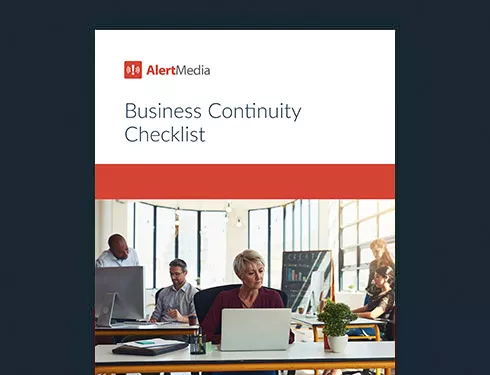
Achieving Enterprise Resilience In a Time of Uncertainty
Organizations that can’t anticipate, withstand, and adapt to disruptive forces eventually fall behind. It’s never too early to start developing resilience; don’t wait until it’s too late.

From public health crises to war to inflation and supply chain issues, businesses today face more volatility and risk than ever before. It’s why, according to research by McKinsey, the top priority for CEOs is now building enterprise resilience. As these CEOs recognize, resilience is an absolute necessity in today’s turbulent landscape.
But resilience is about more than just responding to a single catastrophe. It’s the ability to continue functioning no matter what comes your way. This means creating a culture of resilience—from the boardroom to the front line and beyond.
With an effective enterprise risk management framework, you can keep your business in sound health—strengthening your “corporate immune system”—so you can get back on a progressive track after misfortune strikes.
Download Our Business Continuity Checklist
“Resiliency is about making sure that we’re able to go forward. Some people talk about resiliency as bouncing back. I don’t want to bounce back. I don’t want to bounce back to where we were before. I want to bounce forward. I want to make sure I have stepping stones in place that I can use to propel over the next situation if I can.”
—Michele L. Turner, author and Senior Director of Continuity and Resilience at Expedia Group
In this article, we’ll explore what business resilience is (and isn’t), how it can help you prepare for and respond to crises, and the key components of an enterprise resilience framework. We’ll also delve into real-world examples of enterprise resilience in action to get you started on the path to building a more resilient organization.
What Is Enterprise Resilience?
At its core, enterprise resilience is the ability to anticipate, withstand, and adapt to disruptive forces. It involves developing systems and processes that allow your organization to respond effectively and quickly to unexpected events, such as natural disasters, cyberattacks, or other crises. It also requires creating robust business continuity plans that ensure operational stability under any circumstances.
An effective enterprise business resilience strategy starts with understanding the potential risks and threats to your business operations. This includes identifying areas of vulnerability, planning for possible disruptions, developing mitigation strategies, and creating a process for monitoring and responding to emerging risks.
Business resilience vs. business continuity
It’s important to note that business resilience and business continuity are two different but related concepts. Business continuity focuses on the actions needed to maintain operational resilience during a specific, short-term disruptive event—like a data breach, power outage, or earthquake. It involves planning how your organization will continue critical functions, minimize damage, and resume normal operations as quickly as possible.
By contrast, business resilience is more strategic than its process-driven business continuity counterpart. Resilience is about having systems and processes that protect against unforeseen shocks and building long-term organizational agility, enabling an enterprise to adapt quickly to changing circumstances.
Why Is Enterprise Resilience Important?
Although we can’t predict how or when they’ll occur, unexpected disruptions are inevitable in business. Building resilience into your business model enables your organization to cope successfully with these disruptions and remain competitive, no matter the circumstances. Resilience gives you the power to control your future and achieve your strategic objectives—even when you can’t control the broader conditions in which you operate.
A resilient enterprise is better prepared to handle any crisis that comes its way, minimizing disruption and damage while boosting customer confidence. It also helps organizations become more agile and innovative, as they are better able to pivot in response to changing market dynamics.
Developing an Enterprise Resilience Framework
While there isn’t a single playbook for developing resilience, a balanced focus on the following components of planning and preparedness can help you craft a comprehensive enterprise resilience framework:
- Risk management: Establish systems and processes for assessing, monitoring, and mitigating risks across all business units.
- Business continuity planning: Develop plans that ensure critical operations remain up and running in the event of a major disruption or disaster.
- Disaster recovery: Create a plan for recovering and restoring operations in the aftermath of an emergency.
- Crisis communication: Develop protocols for internal and external communication during difficult times.
- Training and education: Ensure employees understand their roles and responsibilities through crisis management training.
With a comprehensive enterprise resilience plan, organizations can be better prepared to respond quickly and effectively to any crisis. As a result, they can continue operating with minimal disruption, reducing a disaster’s financial and operational impact. We can learn a lot from real-world case studies in enterprise resilience.
A Real-World Example of Enterprise Resilience: JetBlue
JetBlue Airways demonstrates an ongoing commitment to the entire enterprise resilience framework, from risk assessment to crisis communication and training. Every year, leaders conduct a hazard risk survey and send it out to stakeholders, including the crisis management team. The survey lists 40 different crisis events the company could face, and participants are asked to score each crisis, considering the impact on the business, its facilities, and employee safety. The survey also asks them to report how ready they think the organization is to face each crisis. This survey helps to establish a baseline for the organization’s level of resilience with each new year and to prioritize preparedness efforts where readiness is lacking.
“We are constantly promoting preparedness and finding ways to engage our teams. Crisis preparedness is part of our DNA. You can’t let your emergency plans sit and collect dust. Having an active program is essential to keeping employees safe.”
— Penny Neferis, Director of Business Continuity and Emergency Response, JetBlue
JetBlue has more than 24,000 employees and serves millions of customers every year. It’s a tall order for their Emergency Response, Business Continuity, and System Operation Safety teams to keep people safe across nearly 100 locations around the world. The ability to rapidly adapt and pivot resources is crucial to overcoming unplanned disruptions. Recognizing this, teams at JetBlue are continually improving activation, training, and communication of robust crisis response plans for a wide range of threats—from severe weather to active shooters to the pandemic.
JetBlue uses emergency communication software for both real and simulated scenarios. In May 2022, for example, when a mass shooting event in the Buffalo area threatened its team members, JetBlue was able to rapidly notify and confirm the well-being of all employees in the area. Later that year, JetBlue conducted a large-scale emergency exercise with its two-way communication solution—requiring the coordination of over 500 personnel—to ensure every employee would know what to do in a crisis.

Penny Neferis is Director of Business Continuity and Emergency Response. She warns, “You can’t let your emergency plans sit and collect dust. Having an active program is essential to keeping employees safe.” On a quarterly basis, they conduct tabletop exercises with their crisis management team, testing surprise scenarios and quick decision making. They also conduct company-wide exercises to bring emergency planning to life for employees. For enterprise resilience, teams must be ready to act even when a crisis scenario is unfamiliar. Up-to-date plans, regular training, and efficient communication are all critical for sustainable emergency preparedness.
Setting Your Enterprise Up For Success
Emergency communication and proactive threat intelligence are essential for any organization looking to build enterprise resilience. With a focus on timely, accurate communication to mitigate risk, companies can ensure their operations are secure, their employees stay safe, and customers continue to get the quality service they expect.




